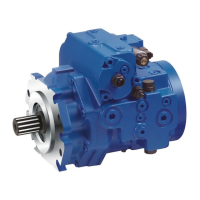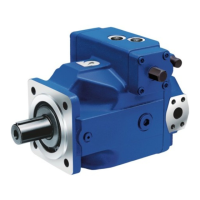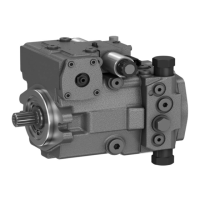Commissioning 45/64
RE92035-01-B/2019-11-25, A4VG Series35, Bosch Rexroth AG
8.1.1 Filling the axial piston unit
Professional filling and air bleeding is necessary to prevent damage to the axial
piston unit and to maintain proper function.
Usually, the cleanliness level of commercial hydraulic fluids is insufficient for the
requirements of our components. These hydraulic fluids must be filtered during
filling using an appropriate filter system to minimize solid particle contamination
and water in the system.
Use only a hydraulic fluid that corresponds to the following requirements:
You can find details on the minimum requirements for hydraulic fluids in
BoschRexroth datasheets 90220, 90221, 90222, and 90225. The titles of the
datasheets can be found in Table 1 "Required and supplementary documentation"
on page5.
BoschRexroth evaluates hydraulic fluids on the basis of the Fluid Rating
according to datasheet90235. For hydraulic fluids which have been positively
evaluated in the Fluid Rating, please refer to datasheet90245 "BoschRexroth
fluid rating list for Rexroth hydraulic components (pumps and motors)".
Thehydraulic fluid should be selected so that the operating viscosity in the
operating temperature range is within the optimum range
(ν
opt
;seeselectiondiagram in the datasheet92035).
To ensure the functional reliability of the axial piston unit, the hydraulic fluid must
have a min. cleanliness level of 20/18/15 as defined in ISO 4406. At a hydraulic fluid
viscosity of less than 10mm²/s (e.g.due to high temperatures during short-term
operation) at the drain port, a cleanliness level of at least 19/17/14 according to
ISO4406 is required. You can find details on the permissible and optimal viscosities
and admissible temperatures in datasheet92035.
Proceed as follows to fill the axial piston unit:
1. Place a drip tray under the axial piston unit to collect any hydraulic fluid that may
leak.
NOTICE! Contaminated hydraulic fluid!
The cleanliness levels of commercial hydraulic fluids are usually insufficient for the
requirements of our components.
▶ Use a suitable filter system to filter hydraulic fluids during filling to minimize solid
particle contamination and water in the hydraulic system.
2. Fill and air bleed the axial piston unit viathe appropriate ports; seechapter 7.3
"Installation position" on page32. Also fill the hydraulic lines of the system.
Procedure

